Exploring the Dynamics of Foil Kiteboarding
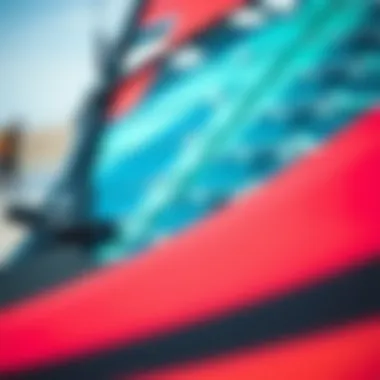
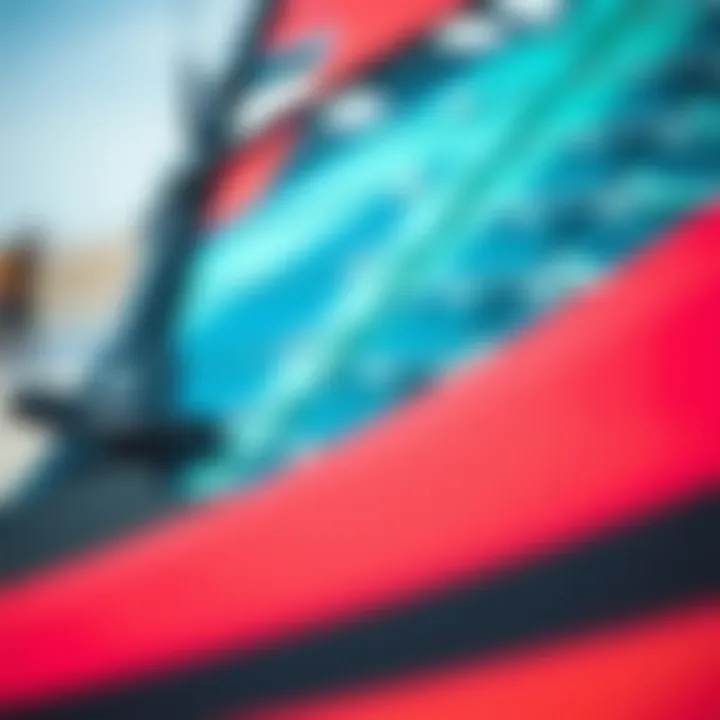
Intro
Foil kiteboarding has sprouted from its traditional roots into a fascinating and dynamic sport that captures the imagination of thrill-seekers and water enthusiasts alike. It's like stepping into a different realm of kiteboarding, one where the interaction between the kite's lift and the board's hydrofoils propels riders to smooth, elevated experiences above the water.
The sheer elegance of foil kiteboarding lies in its unique characteristics. Unlike conventional kiteboarding, where the board rides on the water's surface, foil kiteboarding allows a rider to glide above it, reducing drag and letting them cut through the elements with remarkable efficiency. As such, this discipline has something to offer for everyone, from seasoned riders seeking a new challenge to beginners drawn in by its promise of fluid motion and less resistance.
In this guide, we will navigate through the many layers of foil kiteboarding, discussing gear selection, skill development, safety considerations, and innovations driving this sport forward. By understanding the key components of this exciting activity, readers can enhance their skills, ensure safety, and appreciate the multifaceted nature of foil riding.
Let’s begin with the essentials, focusing initially on how to choose the right gear for this thrilling endeavor.
Intro to Foil Kiteboarding
Kiteboarding has always been synonymous with the thrill of speed, aerodynamics, and freedom. Among its various forms, foil kiteboarding stands out as a cutting-edge discipline that invites enthusiasts to rethink the way they interact with the wind and water. This article embarks on an exploration of the intricate world of foil kiteboarding, revealing its unique traits and advantages, while also imparting essential techniques and safety measures.
Understanding foil kiteboarding is not merely about grasping its definition; it's about grasping its context within the broader landscape of action sports. Foil kites, equipped with hydrofoils, allow riders to glide over surfaces, offering a surreal experience akin to flying just above the water's surface. The suspension above the waves not only elevates the sensation of speed but also opens up a realm of possibilities for maneuvering, making it a favorite among adrenaline seekers.
Key points to consider in this section include the intricacies of foil kite construction, the benefits it provides, and the holistic view of its evolution. Mastering these elements not only heightens the enjoyment for new and seasoned riders alike but also ensures safety and sustainability within the sport. As we delve deeper into the subtopics that follow, the synthesis of history, technical know-how, and environmental consciousness forms the core of this engaging narrative.
"Foil kiteboarding transforms the art of riding into an experience that transcends mere sport; it's about becoming one with the elements."
Essentially, expanding one's knowledge of foil kiteboarding is an investment into a potentially lifelong passion, where each session can lead to discoveries and personal growth, both on and off the water. It nudges the adventurer in us to seek out ideal locations, familiarise ourselves with optimal wind conditions, and gear up with the right materials. The journey into the depths of foil kiteboarding promises not just skills but also a sense of community and belonging among fellow kiteboarding aficionados.
In the sections that follow, we will dissect the definition and context of foil kiteboarding, and traverse through its historical development. It's a fascinating voyage that reveals how this discipline has evolved, overcoming challenges, and reinventing itself into a mainstream phenomenon. With every detail, we'll aim to provide a cohesive understanding that respects both the heritage and the future of foil kiteboarding.
The Anatomy of a Foil Kite
Understanding the anatomy of a foil kite is crucial for anyone eager to grasp the essentials of foil kiteboarding. A well-designed foil kite can significantly influence performance, stability, and overall enjoyment during rides. This section digs into the specific elements that characterize these kites, highlighting their advantages and considerations that every kiteboarder should keep in mind.
Materials and Construction
The materials and construction of a foil kite are what set it apart from traditional kites. Primarily, they are constructed from lightweight, durable fabrics like ripstop nylon or polyester, designed to withstand both the rigors of the sea and the wear and tear of frequent use. The choice of materials not only affects flexibility and strength but also plays a major role in the kite's overall buoyancy.
Foil kites typically consist of several parts, including:
- Leading Edge: This is the kite's frontmost edge and is vital for its aerodynamics. A well-constructed leading edge ensures the kite glides smoothly through the air.
- Cells: Unlike traditional kites, foil kites have cells that inflate when the kite takes flight. This structure provides lift while helping to maintain shape during flight.
- Bridle System: The bridle system regulates the shape and angle of the kite in flight, ensuring it remains stable regardless of varying wind conditions.
The construction method greatly affects performance. For maximum durability, high-quality stitching and reinforced seams are necessary. Cheaper kites may cut corners in this area, which could lead to issues down the line. Selecting a kite made from materials that resist UV radiation can extend the lifespan significantly—ensuring that your investment lasts longer during those sunny days out on the water.
Wing Design and Functionality
The wing design of a foil kite directly influences its functionality and performance characteristics. When you think about how a kite interacts with the wind, it’s essentially a game of lift and drag that allows it to soar gracefully above the water.
Foil kites tend to have a flatter profile compared to traditional kites. This design enables them to harness wind more efficiently, reducing the drag force that can impede speed. The angle of attack, or the angle at which the kite meets the wind, is also adjustable and can optimize performance based on wind conditions.
Another critical aspect of wing design is the aspect ratio. Kites with a higher aspect ratio will generally be faster and provide less power in lower winds. On the other hand, those with a lower aspect ratio are more stable in gusty conditions and can be more forgiving for beginners. Thus, understanding these nuances can be crucial for tailoring your equipment to the conditions and your skill level.
Inspired by the mechanics of aviation, wing shapes can vary greatly as well. A pointed wing might allow for better chopping through stronger winds, while a wider wing design can help create more lift and keep you afloat on the water.
"The wing structure is like the bread and butter of a foil kite; it’s got to be just right to ensure a smooth ride!"
In summary, both the materials and the wing design play an instrumental role in how a foil kite performs. It’s about striking the right balance between durability, efficiency, and maneuverability, allowing kiteboarders to not just ride but soar in their environments.
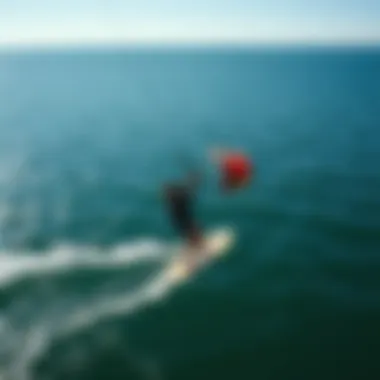
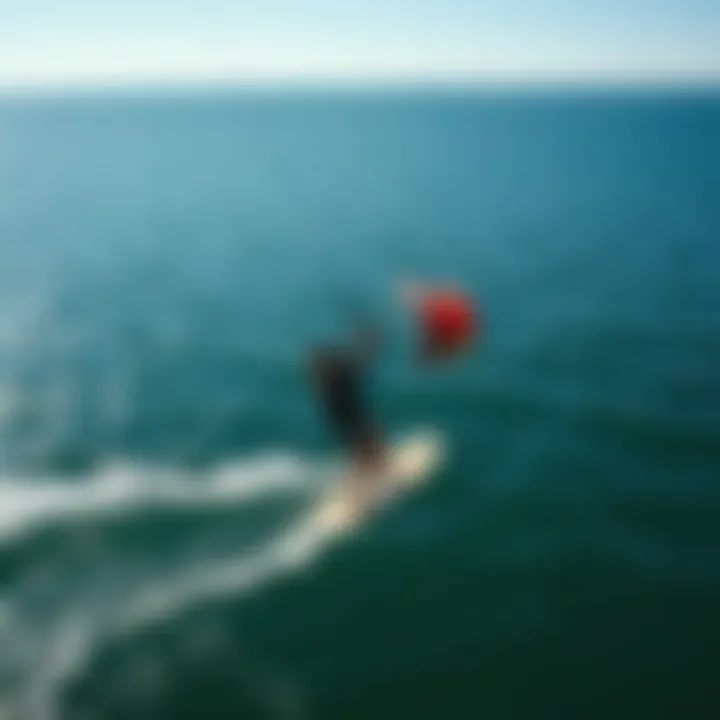
Fundamental Principles of Flight
Understanding the fundamental principles of flight is crucial not only for kiteboarding enthusiasts but also for anyone looking to really harness the power of the wind. In foil kiteboarding, these principles play a pivotal role in how the kite interacts with the air, ultimately determining how effectively the rider can fly across the water. When one grasps the core concepts of lift and drag, alongside the influence of wind conditions, it opens a world of possibilities for optimizing performance and enjoying smoother rides.
Lift and Drag Explained
Lift and drag are two key forces that are generated when the kite moves through the air.
- Lift is the upward force that allows the kite to rise into the air. This force is produced by the design of the kite wing and the angle at which it meets the wind. Generally speaking, a well-shaped wing deflects air downward, thus pushing the kite upward.
- Drag, on the other hand, is the resistance the kite faces as it moves forward through the air. This force acts in the opposite direction to the kite's motion and can inhibit speed. There are two types of drag to consider: parasitic drag, which is due to the kite's shape, and induced drag, which results from the lift being produced.
How these two forces work in tandem determines the efficiency of a foil kite. To achieve optimal performance, riders and designers alike must strike the right balance. A common observation is that as lift increases with speed, drag also tends to rise, creating a delicate interplay that riders must master. For instance, kite designs frequently come into play, the more efficient the wing, the less drag one will encounter.
"Mastering lift and drag is essential for any foil kiteboarder. It's not just about flying; it's about flying efficiently!"
The Role of Wind Conditions
Wind conditions are the unsung heroes of kiteboarding. The dynamics of wind can incredibly affect the lift and drag experienced by a kite on the water.
- Wind Speed: Each foil kite is designed to perform under specific wind conditions. Strong winds can increase lift faster but also lead to increased drag if not handled properly. Inexperienced riders may find themselves overpowered in these conditions, affecting stability and control.
- Wind Direction: The angle of the wind can also affect how well a rider can harness lift. Crosswinds and headwinds offer different challenges and opportunities. Understanding wind direction allows riders to optimize their kite's position relative to the wind, leading to better lift and reduced drag.
- Wind Turbulence: Unlike ideal smooth airflow, turbulence can result from nearby obstacles such as buildings or trees. This chaotic movement affects lift and can catch riders off guard. Learning to anticipate and navigate through turbulent areas is essential for maintaining control and improving performance.
In summary, when kiteboarders have a firm grasp of the forces at play and are aware of how wind conditions can change their ride, the experience becomes not just enjoyable but exhilarating. Embracing the mechanics of lift and drag alongside varying wind conditions elevates a rider's skill set, leading them to unlock the true potential of foil kiteboarding.
Techniques for Effective Foil Kiteboarding
Foil kiteboarding might seem like an expression of freedom and thrill, but its core principles hinge on techniques that transform these exhilarating experiences into safe and enjoyable rides. This section emphasizes the importance of mastering effective techniques for engaging in foil kiteboarding. Those who fully understand these methods can ride the winds with confidence, making the sport not just a pastime but a reliable skill set.
Stance and Balance
The stance and balance of a foil kiteboarder are fundamental aspects that directly influence performance and safety on the water. When a rider hits the water, positioning and balancing the body can determine how well they maneuver through varying conditions. A good starting point is to maintain an athletic stance—knees slightly bent, feet shoulder-width apart, and weight evenly distributed. This stance allows for better control and makes shifting weight easier when responding to wind changes.
A common pitfall is failing to harness the power of the kite by leaning too far back or too far forward. Riders should strive for a centered position over the board. Imagine trying to balance on a tightrope; it’s similar. Keeping the center of gravity low will provide stability. Additionally, a gentle flex in the knees helps absorb any chop that might be kicked up by the water, preventing jarring movements that can lead to falls.
In practice, a routine that includes strengthening core muscles can enhance stability while riding. Exercises like planks or even simple yoga poses can aid in building the necessary balance. Also, practicing turns and transitions in calm waters before tackling more challenging conditions can lead to more confident riding overall.
Launching and Landing Procedures
Getting the kite in the air and bringing it back down safely can be more complex than it seems. Improper launching and landing procedures can spell disaster, potentially leading to injuries. A solid launch starts with two key factors: communication and positioning.
Preparing the kite for launch typically involves selecting a suitable spot, away from obstacles, and ensuring the lines are unambiguously untangled. Riders should coordinate with their assistants (if they have one), using clear verbal cues to indicate when they are ready for the kite to be launched. Ensure the wind direction is checked before launching, as this can significantly affect the kite's performance.
After the kite is airborne, it's essential to maintain focus. Once the rider is in the water, they should allow the kite to find its sweet spot in the wind window—often midway above their head. A common misstep is letting the kite drift too low, causing a loss in lift and, subsequently, control.
When it comes to landing, the approach should be methodical. Riders should signal to their assistants that they're ready to land, then begin to descend the kite slowly. It’s crucial to angle the kite gently downwind to bring it down smoothly. If conditions are rough, establishing a safe distance from any possible obstruction is vital. The process can be daunting for beginners, but with practice, it becomes second nature.
Remember: Proper launching and landing techniques are not just safety measures; they reflect professionalism in the sport.
In summary, developing effective techniques for stance, balance, launching, and landing is not merely about getting by on the water; it's about cultivating a skillful practice that enhances safety and enjoyment. Every practitioner, regardless of experience level, should continually refine these skills to ride with confidence and finesse.
Environmental Considerations
In the realm of foil kiteboarding, understanding environmental considerations is not just a side note; it’s a fundamental aspect that shapes the entire experience. The natural world imposes limits and opportunities that both novice and seasoned kiteboarders must recognize. Not only does this knowledge enhance safety, but it also aids in developing a deeper respect for the ecosystems we play in. Let's delve into the varied factors that influence optimal kiteboarding experiences.
Ideal Locations for Foil Kiteboarding
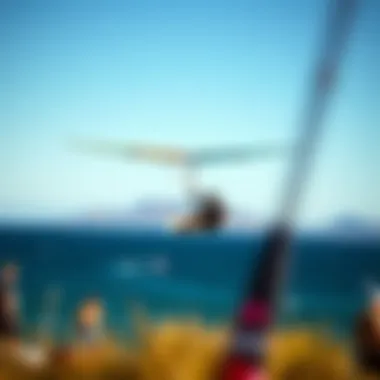
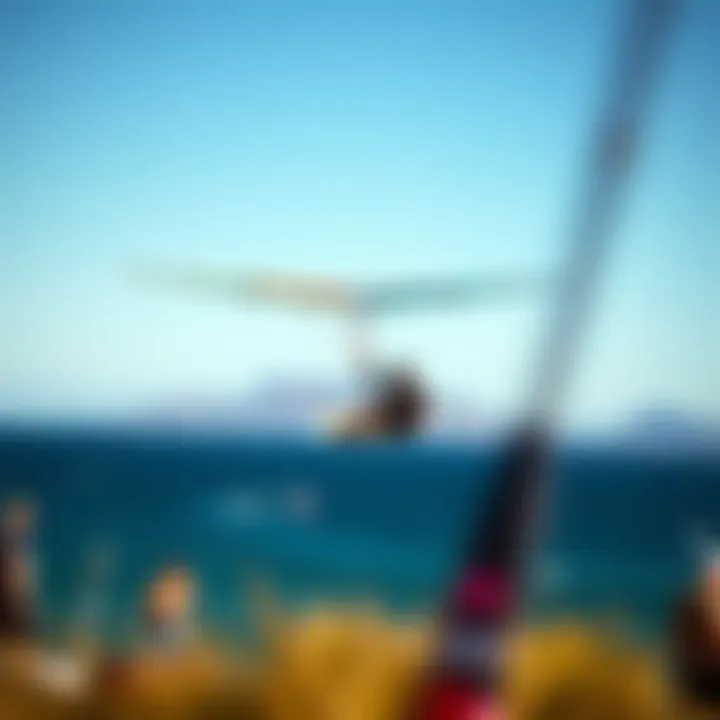
Choosing the right location can make or break your ride. Foil kiteboarding thrives in areas where water and wind collaborate harmoniously, creating a playground for enthusiasts.
- Flat Water Spots: Places like lakes or bays with minimal waves are ideal. The absence of choppy water allows for a smoother ride. For instance, the bays near La Ventana, Mexico, offer flat water conditions that are a magnet for kiteboarders.
- Open Beaches: Beaches with ample space for take-off and landing give riders the freedom to explore. Locations such as Cabarete in the Dominican Republic boast expansive sandy shorelines, making it a prime spot.
- Tidal Areas: Graphing tides is crucial. Locations like Foil Cove in the UK can offer fantastic conditions at certain tide cycles, allowing for exhilarating sessions.
Remember, the ideal spot not only enhances enjoyment but also opens possibilities for learning and connecting with fellow riders.
Weather Patterns and their Impact
Weather patterns hold significant sway over foil kiteboarding—knowing when and how conditions shift can make a world of difference.
- Wind Direction and Speed: Steady winds blowing in a consistent direction are what every kiteboarder dreams of. Typically, wind speeds of 12 to 25 knots are considered optimal for foil kiteboarding. Too little wind and it's like trying to sail with no breath in your sails. Too much wind can turn the adventure into a wild ride that lacks control.
- Temperature Considerations: While mid-range temperatures are comfortable for riding, knowing how different weather conditions can affect your gear is also vital. In tropical spots, heat may cause certain kite materials to expand, while cold weather can stiffen them, altering performance.
- Storms and Turbulence: Awareness of changing weather is key. Sudden storms can bring dangerous gusts or unpredictable shifts in wind direction. Always keep an eye on local weather forecasts before heading out.
- Seasonal Variability: Depending on geographical location, seasons alter kiteboarding experiences significantly. For example, winter in Cape Town turns the Table Mountain into a ramp, offering consistent winds that are hard to resist.
"Understanding the weather is akin to reading the ocean’s mood. Ignoring it may leave you in choppy waters!"
Incorporating awareness of environmental conditions in kiteboarding practices not only enhances performance but also fosters a culture of respect toward nature. This awareness ultimately enriches the thrill of foil kiteboarding, making it a sport that harmonizes adventure and environmental stewardship.
Safety Protocols in Foil Kiteboarding
Safety should never take a backseat in any sport, especially one as exhilarating as foil kiteboarding. This discipline combines the elements of wind, water, and physical agility, often presenting an ingredient for high-risk scenarios. Therefore, understanding and adhering to safety protocols are paramount for both novice and experienced riders alike. Effective safety measures not only enhance the enjoyment of the sport but also minimize the perilous elements inherent in kiteboarding.
Understanding Risks and Hazards
Embarking on a foil kiteboarding adventure means acknowledging the variety of risks involved. Weather conditions play a crucial role; sudden gusts can easily lead to loss of control or accidents. Slippery surfaces, unexpected obstacles in the water and even the presence of other water users can lead to dangerous situations. Here are some common considerations:
- Wind Velocity: Too much wind can make it challenging to control the kite. Riders should always check wind conditions and gain experience before tackling high winds.
- Ocean Currents: Recognizing the strength and direction of currents is vital. It is easy for a rider to be swept off course, leading to potential hazards.
- Navigation Obstacles: Be mindful of buoys, boats, and even sandy shoals, which can pose significant risks while riding.
"The sea is a treacherous dance floor; one false move and it can lead to a slippery situation."
Essential Safety Gear
Equipping oneself with the right safety gear cannot be overstated. Investing in quality equipment not only boosts confidence but can also be a lifesaver. Below is a list of key safety items to consider when foil kiteboarding:
- Helmet: Protects the head during unexpected crashes or falls.
- Impact Vest: Provides buoyancy and safeguards the torso from impact.
- Leashes: Keeps the kite tethered in case of a wipeout, preventing it from flying away.
- Wetsuit: Offers warmth and minimizes injuries from falls into the water, acting as a second layer of skin.
- Safety Knife: A handy tool for emergencies, especially if the lines become entangled. This could potentially save lives.
Maintenance and Care for Foil Kites
In the exhilarating realm of foil kiteboarding, the performance and longevity of your equipment depend significantly on proper maintenance and care. Foil kites, with their intricate materials and unique designs, require a keen eye and a hands-on approach to ensure they remain in top shape. A neglected kite can lead not only to diminished performance but also potential risks during maneuvering. Thus, developing a routine for consistent care can not only enhance your riding experience but save money in the long run. Here, we delve into two critical areas: routine inspections and repairs, and effective storage techniques.
Routine Inspections and Repairs
Regular inspections are your first line of defense against damage and performance drop-offs. Inspecting your foil kite should become as second nature as checking the forecast before a session. Here are some essential steps to take:
- Visual Check: Look for any signs of wear such as small tears, fraying lines, or warped wings. Any visible damage should be addressed immediately to prevent it from worsening.
- Line Integrity: Examine your lines for tangles or kinks. A tangled line can cause imbalance, making control difficult and potentially dangerous.
- Connectors and Hardware: Ensure that all connectors and hardware are secure and free from rust or corrosion. Pay special attention to the bridle, as it is integral to your kite's performance.
Beyond mere visual checks, conducting repairs can be a straightforward task with the right approach. For minor tears, having a patch kit on hand can be a saving grace. Such kits typically contain material and adhesive specifically designed for restoring kite fabrics. A well-repaired tear can extend the life of a kite for several seasons, ensuring you get the most bang for your buck.
"An ounce of prevention is worth a pound of cure." Keeping your kite in check today can spare you a world of trouble tomorrow.
Storage Techniques
When not in use, proper storage can greatly impact the lifespan of your foil kite. Here are some methods to consider:
- Dry Conditions: Always store your kite in a dry area. Exposure to moisture can lead to mold and mildew, which can degrade the materials.
- Avoid Direct Sunlight: Prolonged exposure to UV rays can weaken the fabric and affect performance. Consider a storage bag that blocks UV rays for added protection.
- Unpack Carefully: When putting your kite away, ensure it’s fully deflated and free of sand or debris. Rolling it up carefully minimizes stress on the seams and minimizes crinkles.


Community and Foil Kiteboarding Events
Foil kiteboarding, a sport that has taken to the skies, thrives not just on the waves and winds but also through its vibrant community. Engaging with fellow enthusiasts and participating in events can amplify both skills and enjoyment. This section explores the essential role community plays in foil kiteboarding, highlighting local collectives, competitions, and gatherings that knit this sport together.
Joining Local Collectives
Being part of a local collective is more than just meeting up before hitting the water. It's about fostering a sense of belonging while learning from each other’s experiences. Collectives often include riders of various expertise levels, making them an excellent resource for novices seeking guidance or seasoned riders looking to refine their technique. The atmosphere of support shared in these groups encourages individuals to push boundaries, experiment with new tricks, and share invaluable tips.
This camaraderie brings a few benefits to the forefront:
- Skill Enhancement: Through shared knowledge, individuals can learn faster and master new skills effectively.
- Equipment Recommendations: Members often share insights about gear that works best in local conditions, which can save time researching.
- Safety in Numbers: Having a community around can be critical for safety, as group riding provides additional support and a watchful eye on potential hazards.
Moreover, collecting with locals often means easier access to lesser-known spots, avoiding busy areas for a more tailored riding experience. Opportunities for organized meetups come through social media platforms like Facebook or Reddit, where riders can find others who share their passion.
Competitions and Gatherings
Competitions and gatherings are the heartbeat of any sport, and foil kiteboarding is no different. These events can range from friendly contests among locals to large-scale competitions attracting talent from all over. Entering competitions provides a platform for riders to showcase their skills and learn valuable lessons from observing others. Competitive settings push riders to perform at their peak, forging resilience and discipline.
"Competition isn’t just about winning; it’s about learning from each flight and enjoying the thrill of the sport with fellow riders."
Events also serve as significant social occasions, allowing enthusiasts to connect beyond just the sport. They can bring together people from various backgrounds, fostering friendships that often extend beyond the water.
- Networking Opportunities: Engaging with brands and sponsors during these events can open doors for future endorsements or collaborations.
- Gaining Exposure: For up-and-coming riders, competing can lead to exposure in publications, leading to positive feedback and recognition.
- Celebration of Culture: Events often include festivities that celebrate the lifestyle associated with foil kiteboarding, allowing participants to experience the culture deeply.
Innovations in Foil Kiteboarding
Foil kiteboarding is as much about progress as it is about technique. The advances in this realm of the sport can make the difference between an average ride and an extraordinary experience. Innovations not only serve to enhance performance, but they also contribute to the safety and enjoyment of riders. In this section, we will look at both technological advancements that have altered the landscape of foil kiteboarding and future trends that enthusiasts can expect to see.
Technological Advancements
In recent years, the world of foil kiteboarding has witnessed an explosion of technological innovations that have fundamentally changed the experience of riding. These advancements encompass everything from the materials used to construct foils to the design features that enhance performance.
- Materials: Lighter and stronger materials, such as carbon fiber and high-modulus polyethylene, have surged in popularity. These allow for a substantial reduction in weight while maintaining strength, leading to better lift and maneuverability on the water.
- Hydrodynamics: The design of foil wings is tailored for efficiency; thinner profiles reduce drag and improve gliding speed. Some manufacturers have experimented with wing shapes that increase lift at lower speeds, making it easier for beginners to get up and ride even in lighter winds.
- Control Systems: Modern options like variable geometry kites allow riders to adjust wing shape and camber while in use, providing an ability to fine-tune the kite’s performance under differing wind conditions.
These advancements mean not only better rides but more accessibility for newcomers. Furthermore, the innovations in control systems ensure that even with more power, a rider has a greater capacity to maintain stability and manage speed.
Future Trends to Anticipate
Just as we have witnessed significant advancements over the past years, the future of foil kiteboarding promises to be even more dynamic. It's crucial for riders and would-be enthusiasts to keep an eye on several emerging trends that can shape their experience.
- Smart Technology Integration: Expect to see kites fitted with sensors to monitor wind conditions in real-time. Such kites could automatically adjust themselves for optimal performance, helping riders to better adapt to changing scenarios.
- Eco-Friendly Practices: As environmental concerns grow, producers are likely to focus on sustainable materials and practices. Innovations could include biodegradable kites or recyclable components, which would benefit the community by reducing ecological footprints.
- Enhanced Learning Tools: With the rise of platforms for riding analytics, more riders will have the resources necessary to learn the sport safely and effectively. Interactive apps could provide feedback on stance, speed, and kite handling.
- Community-Driven Designs: As kiteboarding communities grow, the need for a range of gear suitable for diverse skill levels will foster collaborative innovations. New riders might influence designs to ensure they feel safe and encouraged without sacrificing performance.
"Adaptability is key to enjoying the water. The innovations that come will make every ride a chance to grow and experiment."
Innovations in foil kiteboarding are not merely about performance, but also about enhancing the community and environmental consciousness of the sport. For both seasoned riders and newcomers, these advancements represent a thrilling evolution of kiteboarding, creating opportunities for unforgettable experiences on the water.
End and Final Thoughts
In wrapping up the exploration of foil kiteboarding, it becomes clear that this dynamic sport encapsulates much more than just the thrill of gliding across water. Foil kiteboarding offers a unique blend of innovation and nature’s forces, allowing enthusiasts to experience the exhilaration of flight in a manner unlike any other water sport. This conclusion serves to underscore the various elements discussed throughout the article, highlighting its significance for practitioners at all levels.
Engaging in this sport involves understanding the delicate interplay of materials, design, and environmental influences. With advancements in technology continually shaping the construction of kites, riders have the opportunity to experience heightened performance and control. It's crucial, therefore, not only to grasp the fundamental aspects of foil kiteboarding but also to stay informed about current trends and innovations, which can significantly amplify one’s experience on the water.
"Knowledge is the kite that elevates us; without it, we are bound to the ground."
Safety also plays a pivotal role in this dynamic activity. Recognizing the inherent risks associated with kiteboarding, whether they stem from environmental factors or equipment failures, is essential for ensuring one’s enjoyment and longevity in the sport. Properly understanding safety protocols and investing in high-quality gear cannot be overstated. Such precautions enhance not only personal safety but also contribute to the overall health of the kiteboarding community.
Additionally, maintaining and caring for equipment promotes longevity and effective performance. Regular inspections and thoughtful storage practices ensure that riders can rely on their gear when the conditions are right.
The community aspect of foil kiteboarding enriches the experience, welcoming riders from varied backgrounds to share their passion. Local collectives and events foster collaboration and competition alike, allowing individuals to connect, learn from each other, and grow as kiteboarders. Encouraging interaction within the community can only serve to deepen the appreciation for the sport.















